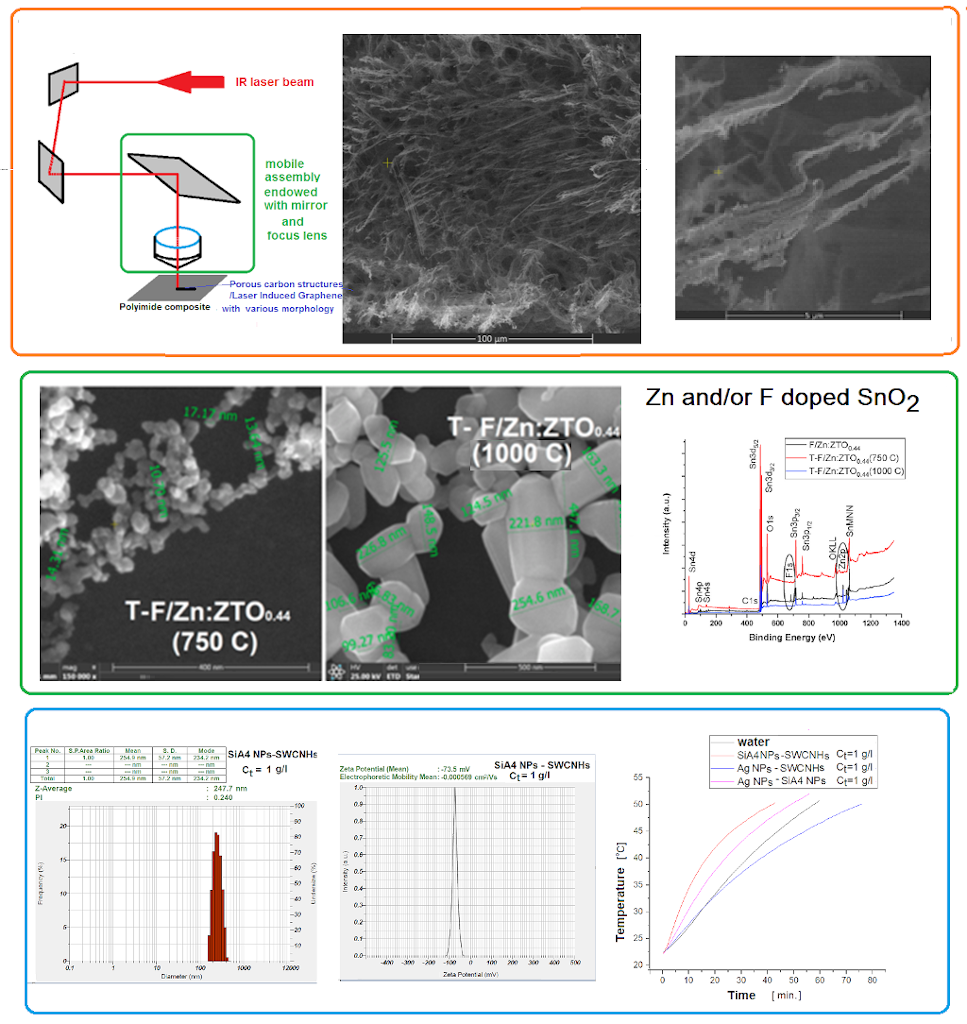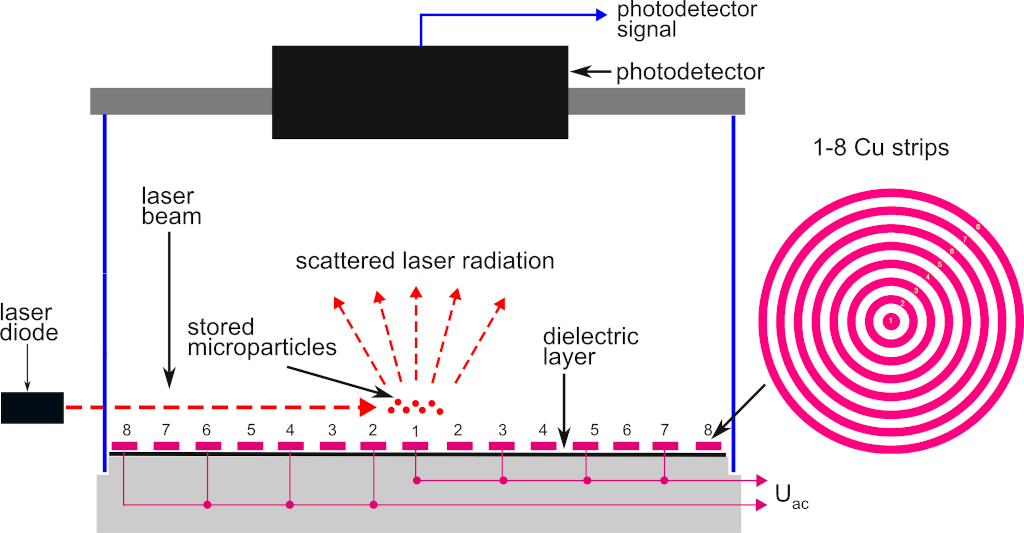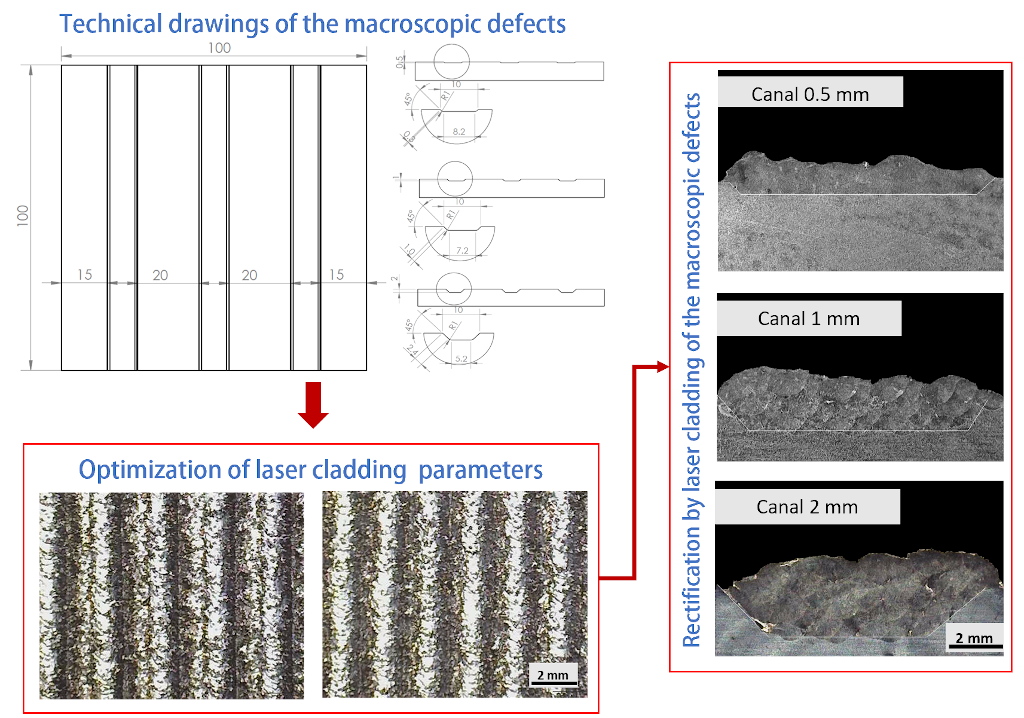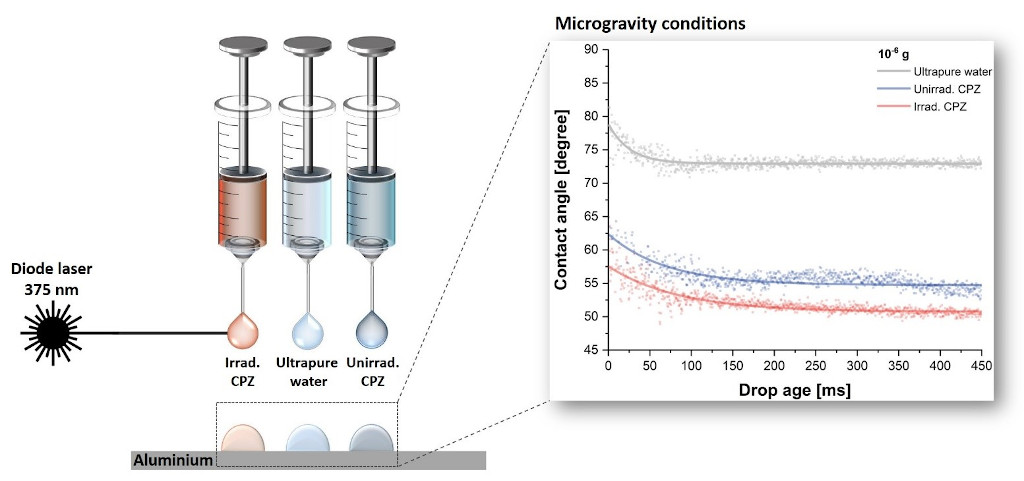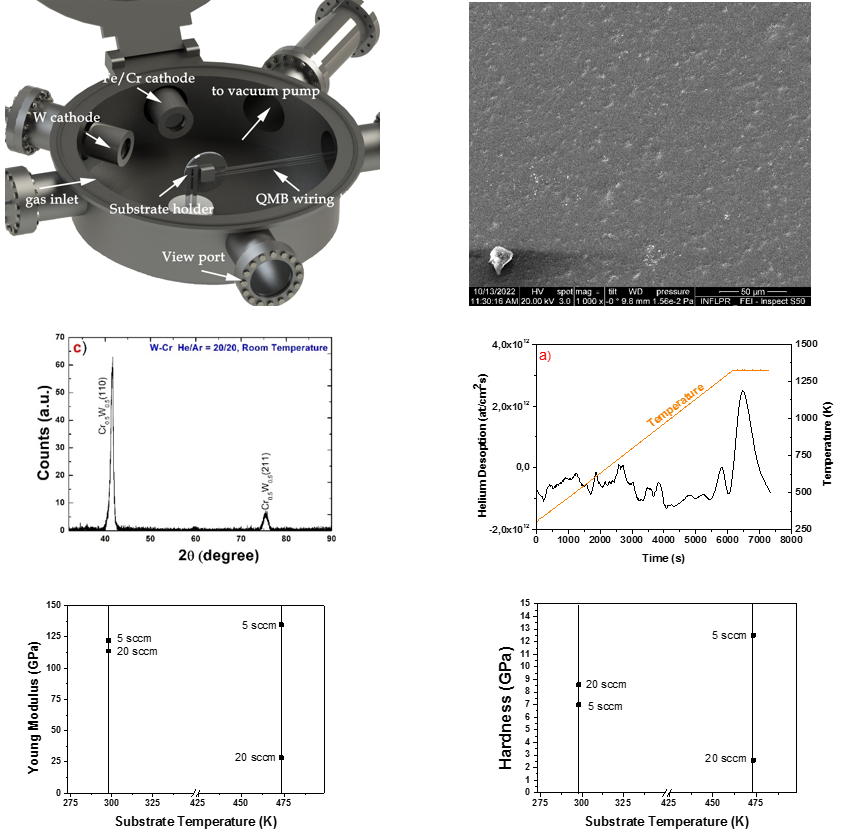
Shema de realizare a proiectului 19 15 01 01 - Anul 2022 - Etapa III
Phase no. 117
Responsible: Dr. C. Fleacă
Deadline: 9.12.2022
Title: "Dezvoltarea de nanostructuri și nanofluide pe bază de nanopulberi compozite sintetizate prin piroliză laser, pentru stocare, generare sau transfer eficient al energiei"
Abstract: The first objective of this phase consisted in the synthesis of carbon nanostructures of Laser Induced Graphene LIG type starting from composites based on polyimide in which other carbon structures were dispersed, composites obtained by mixing polyamic acid with small amounts of graphene oxide or single-walled carbon nanohorns SWCNHs followed by their thermal treatment at 250°C. The composite films were then irradiated with an infrared CO2 laser at different laser powers and beam scanning speeds. The resulting materials were analyzed by SEM and Raman techniques. It was observed that at low powers only an incipient decomposition of the polyimide takes place, higher laser powers being necessary to generate porous carbon nanostructures of the LIG type. They are composed of porous membranes and interconnected filamentary structures. In the presence of SWCNHs and at high powers, predominantly fibrous structures are obtained. The Raman spectra of carbonic structures reveal the presence of sp2 hybridized zones specific to graphite and graphene, but also of a variable percentage of defects. The second objective of this phase was realized in the study of the influence of heating in air at relatively high temperatures of 750 and 1000°C of some nanoparticles based on SnO2 doped with zinc and fluorine obtained by laser pyrolysis of mixtures of Sn(CH3)4 and Zn(C2H5)2 organometallic precursors in the presence of SF6 and air. For comparison, samples without F doping were also synthesized by replacing SF6 with C2H4. Raw and calcined nanoparticles were analyzed by XRD, SEM, TEM, Raman, EDS, XPS techniques. Heating in air leads to an increase in crystallinity and nanoparticle sizes. The treatment at 1000°C leads to the loss of fluorine from their composition, while zinc remains in the crystalline structure. Also, a decrease in oxygen vacancies is found in the calcined samples. The third objective consists in the synthesis and characterization of aqueous hybrid nanofluids for heat transfer/solar heating. Nanofluids stabilized with sodium carboxymethylcellulose with two types of nanoparticles were fabricated. They were synthesized by laser pyrolysis (C(Si), Si, SiC) or by reduction (Ag NPs) or by electrical discharge (single-walled carbon aggregated nanohorns SWCNHs). DLS measurements revealed mean hydrodynamic diameters generally below 250 nm, and the large negative values of the Zeta potential confirmed their stabilization with the anionic polyelectrolyte. Simulation tests of the solar absorption of this nanofluid were performed, observing in certain cases an acceleration of heating compared to pure water in the same configuration.
Graphic abstract:
Phase no. 118
Responsible: Dr. O. Stoican
Deadline: 9.12.2022
Title: "Dezvoltarea de capcane electrodinamice pentru generarea microplasmelor unicomponenta folosind structuri periodice de electrozi"
Abstract: An electrodynamic trap is an electrodes system allowing to maintain a cluster of charged particles in a well-defined region of space without physical contact with a solid support. Due to this feature, it can be used as a tool to hold solid targets of micrometer or nanometer size to interact with laser beams. The objective of the phase project was to devise electrode geometries aimed to maximize the volume of stored particles exposed to the laser beam and observed by the detection instruments, respectively. The volume extension filled by the stored particles and the increase of their visibility was achieved by the periodic insertion in space (3D configurations) or in plane (2D configurations) of groups of similar electrodes. Different arrangements of electrodes consisting of coils made of electrical conductors, in helical and circular geometry, in plane or in space, were tested. Noteworthy results have been obtained using as electrodes a series of circular, concentric metal strips deposited on a dielectric surface. In this way, the whole half-space above the electrodes plane is accessible to the incident laser beam and visible to detection instruments.
Graphic abstract:
Phase no. 119
Responsible: Dr. A. Popescu
Deadline: 9.12.2022
Title: "Repararea prin placare laser a unor piese cu defecte macroscopice"
Abstract: This research study aims the rectification by coating of channels with depths of 0.5 mm, 1 mm and 2 mm, respectively. The experiments were carried out using the coating method by laser cladding with additive material in the form of 304 stainless steel powder particles. In an graphical engineering program were designed the technical drawings needed to create the channels by milling, which represent the macroscopic defects. In order to obtain homogeneous structures without internal defects, 600 W laser power, 0.6 m/min processing speed and 10 g/min powder flow assisted by a He gas mixture (4 slpm, carrier gas) – Ar were used (7 slpm, protective gas) process parameters were used. The width of a single line drawn using the optimal processing parameters was 1.9 mm and the optimal scanning strategy for the channel depth of 0.5 mm was 0.6 mm the distance of the hatch that forms the meander and in case of the other 2 depths (1 mm and 2 mm) the horizontal distance was 1 mm and the vertical distance was 0.6 mm. Using these parameters the rectification of macroscopic defects by laser cladding with additive material was achived and the exceed material was kept at minimal values. The process proved to be thermally stable, the temperature varying between 1030-1100 ⁰C. The lack of thermal fluctuations can be an indicator of the quality of the deposited structures. The cross-sectional microscopic analysis of the samples validated this theory, because all the structures proved to be free of internal defects.
Graphic abstract:
Phase no. 120
Responsible: Dr. M. Boni
Deadline: 9.12.2022
Title: "Studiul proprietăților de udare a suprafețelor de către picături de medicamente expuse la radiație laser în condiții de microgravitație"
Abstract: In this phase, the interaction of UV laser radiation with pendant medicine droplets and their wetting properties on an aluminium surface has been investigated under microgravity conditions. Experiments were conducted at a 10-6 g gravity level at the Bremen Drop Tower (Center of Applied Space Technologies and Microgravity, Bremen, Germany). The wettability of the target surface was evaluated by determining the contact angles and wetted diameters. The studied droplets comprised unexposed and laser-exposed chlorpromazine (CPZ) solutions, as well as ultrapure water (solvent of the drug samples). One of the medicine droplets has been exposed in the microgravity environment to a 375 nm continuous wave laser radiation emitted by a diode laser. The wetting interaction was studied by generating simultaneously three pendant droplets (unirradiated CPZ, ultrapure water and another unirradiated CPZ which has been exposed in real-time to UV laser radiation) in the immediate proximity of the target surface, detaching them onto the aluminium surface, followed by the determination of the contact angles and wetting diameters of sessile drops formed at the liquid-solid-air interface. Droplet generation, behaviour, exposure to laser beam and interaction with the target was visualised and recorded with a high-speed camera, the obtained images being used for post-analysis using the ADVANCE (KRÜSS) software.
Results revealed improved wetting properties of unirradiated and irradiated CPZ solutions in contrast to ultrapure water. Moreover, it has been noted that samples exposed to laser radiation provide better wetting properties compared to the unirradiated ones. These observations are valid both in terrestrial gravity and microgravity. It has also been observed that all solutions show higher contact angle values at 10-6 g compared to 1 g conditions.
The experiment aimed to bring new insight into the behaviour of medicine droplets in a reduced gravitational environment.
Graphic abstract:
Phase no. 121
Responsible: Dr. C. Porosnicu
Deadline: 9.12.2022
Title: "Expunerea filmelor compuse din WFeCr la fluente de ioni de He relevante pentru fuziunea termonucleara"
Abstract: The study of EUROFER 97 type materials, as well as other types of ferritic-matensitic steels, is particularly important in order to use them in the composition of the walls and especially in the co-deposits in the divertor area. These types of materials have multiple benefits, they significantly reduce the retention of nuclear fuel, compared to reactors that use graphite or beryllium as the material for the first inner wall of fusion reactors.
This phase studies the morphology, crystal structure, mechanical properties, retention and desorption of He from nanometer-sized (500nm) W/Cr and W/Fe structures. To create these types of materials, two magnetron sputtering techniques were used in continuous mode and by using a hybrid mode where the cathode provided with the W target was operated in HiPIMS mode. Thus, 12 sets of samples were obtained by varying the flow of He used during the deposition, 5 sccm respectively 10 sccm, but also the temperature applied to the substrate (Room temperature and 437 K). Morphological investigations carried out with the help of SEM on the W substrate showed a morphology that follows the substrate line for both the W/Cr and W/Fe layers. The crystalline nature of the W/Cr type films was evidenced by XRD by the presence of a stoichiometric intermetallic crystalline phase Cr0.5W0.5. The degree of crystallinity of these thin layers is dependent on the He flux and the deposition technique and independent of the working temperature. The mechanical properties were investigated using nano-indentation. The modulus of Young and hardness of W/Cr and W/Fe type films is strongly influenced by the temperature of the substrates during deposition. The retention of He and the release behavior of this gas from W/Cr and W/Fe layers was studied by TDS measurements.
Graphic abstract:

